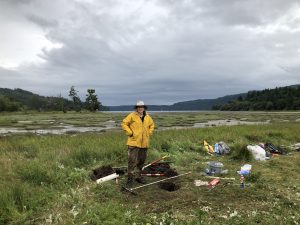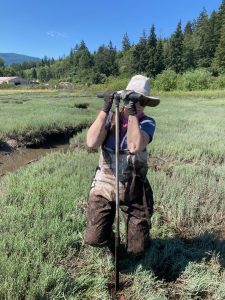Carrie Garrison-Laney’s research paints a fuller picture of Washington’s tsunami risk
From the Summer 2024 Sea Star
By Alison Lorenz, WSG Science Writer

Carrie Garrison-Laney in the field after taking sediment cores.
The Big One. It’s the threat looming over all who live in western Washington and the greater Pacific Northwest: a magnitude 9 earthquake from the Cascadia Subduction Zone. A quake from the fault line stretching from Vancouver Island to northern California could create the kind of devastating tsunami documented in Coast Salish Peoples’ stories 300 years ago. Now, decades after Cascadia’s potential for a huge earthquake–tsunami event was brought to light, the threat is familiar to many. But did you know there are other, smaller fault lines all over western Washington? And that some of them have also produced tsunamis—and will eventually do so again?
These other tsunamis are a research focus of Carrie Garrison-Laney, WSG’s coastal hazards specialist and paleoseismologist. Garrison-Laney was an undergraduate in the San Francisco Bay area during the famous 1989 earthquake that paused the Major League Baseball World Series. “That experience really sealed the deal as far as working in earthquake related science,” she says. But the “how” wasn’t clear until graduate school, when she accompanied a professor to take cores of sediment at a suspected tsunami inundation zone.
The site was a freshwater pond near the beach behind a sandy berm. Once there, they pushed a handheld metal corer meters down into the sediments at the bottom of the pond. When they pulled it out, Garrison-Laney remembers seeing layers of sand in the sediment core. These were tsunami deposits, evidence of times tsunamis washed over the beach and dunes and spread a layer of marine sediment distinct from the peaty pond deposits. In the core, this sediment stood out like frosting between layers of cake.
“It was amazing to me,” Garrison-Laney recalls. “I was so excited.” She’s been looking at tsunami deposits ever since.
Why look at evidence of tsunamis that happened hundreds of years ago? It turns out the answer has a lot to do with preparing for tsunami hazards now. The problem Garrison-Laney’s research tries to address is that tsunami threats in Washington are not well understood. “I’ve been trying to understand the sources of tsunamis in the Salish Sea,” she explains. “We think we know all the faults that can make tsunamis. We know Cascadia makes them, and that we get them from elsewhere in the Pacific Ocean. But we don’t really know enough about which faults around Puget Sound have produced tsunamis.” For example, the geological record shows evidence of seven big earthquakes in western Washington over the past 3500 years. But in Discovery Bay — a bay on the Olympic Peninsula, near Port Townsend — sediment cores hold deposits from ten tsunamis over that same period. “There are extra deposits, and we don’t know where they came from,” Garrison-Laney says. “It’s important to understand that to define the hazard.”

Garrison-Laney drills into the earth to take a sediment core.
Recently, she’s been focused on improving the precision of estimates of tsunami recurrence, or how often tsunamis have occurred as a result of the movements of certain faults. The heart of this analysis is radiocarbon dating. Garrison-Laney’s research has necessitated that she delve deep not only into paleoseismology, but also paleoecology, as the plant and animal life caught up in sediment deposits can help to determine the nature of the sediment, where it came from, and its age. Radiocarbon dating measures the decay of a radioactive isotope of carbon, an element present in all plant and animal life, to pinpoint the age that the organism died — in this case, the plants that were covered in tsunami sand or grew on the sand after the tsunami event. By collecting bracketing ages, researchers statistically determine the span of calendar years when the tsunami occurred.
Even as recently as the eighties and nineties, radiocarbon dating was far from precise. Garrison- Laney explains that in some cases, it would have been impossible to tell whether two tsunamis happened 100 or 300 years apart. Thanks to knowledge gained since then, improved analytical methods, and cheaper high-precision dating, scientists have been able to revisit previously studied sites and sieve them for more information. The Discovery Bay project is a significant success for Garrison-Laney, as she was able to narrow the date ranges of three tsunamis to within 100 years. “When the ranges are smaller, you can feel a lot more confident with making correlations,” Garrison-Laney explains. “We’re seeing a lot of evidence around Washington and Vancouver Island for an earthquake and a tsunami that happened about 600 years ago that we don’t see in southwest Washington.” That is important information: something about the subduction zone that we didn’t know before.
All that being said, Garrison-Laney is cleareyed about the nature of the work. She describes research contributions as small bits that cumulatively, over time, turn into something larger and more significant. That’s why the other piece of her role is sharing tsunami science that is as up to date as possible. She does this through a variety of venues, from serving on the Tsunami Science and Technology Advisory Panel, a standing working group of the National Oceanic and Atmospheric Administration’s Science Advisory Board, to consulting with specific communities about the tsunami risk they face and what they can do to prepare. Some communities are more risk tolerant than others, and decisions can range from where to locate emergency supplies to what actions people should take if the earth begins to rumble beneath their feet. “I think what we should always do is give people enough information that they can incrementally get to a safer place,” she says. Garrison-Laney is a strong believer in vertical evacuation options, and in not giving up if the earth starts to shake — because the earthquake-tsunami event that does happen in our lifetimes may not be the Big One, but a smaller one from a fault you’ve never heard of.
“I work on earthquakes and tsunamis, which are horrible deadly events,” Garrison-Laney says. “That part of it doesn’t excite me, but I do want to understand them. When you can make sense out of it, or help someone else make sense out of it, that helps take some of the fear out of it.”
###
Washington Sea Grant, based at the University of Washington, helps people and marine life thrive through research, technical expertise and education supporting the responsible use and conservation of coastal ecosystems. The National Sea Grant College Program is part of the National Oceanic and Atmospheric Administration, U.S. Department of Commerce.
Join the conversation: instagram.com/waseagrant and Facebook.com/WaSeaGrant.
AUG
2024